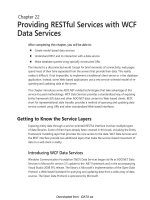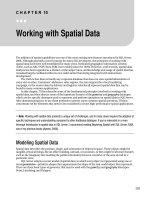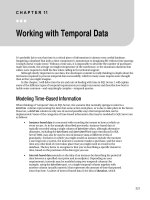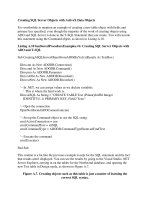Providing RESTful Services with WCF Data Services
Bạn đang xem bản rút gọn của tài liệu. Xem và tải ngay bản đầy đủ của tài liệu tại đây (1.73 MB, 45 trang )
Chapter 22
Providing RESTful Services with WCF
Data Services
After completing this chapter, you will be able to:
Create model-based data services
Understand REST and its interaction with a data service
Make database queries using specially constructed URIs
The Internet is a disconnected world. Except for brief moments of connectivity, web pages
spend most of their time separated from the servers that provide their data. This reality
makes it difficult, if not impossible, to implement a traditional client-server or n-tier database
application. Instead, some Web-based applications use a new service-oriented model of re-
questing and updating data at the server.
This chapter introduces some ADO.NET-related technologies that take advantage of this
service-focused methodology. WCF Data Services provides a standardized way of exposing
Entity Framework (EF) data and other ADO.NET data content to Web-based clients. REST,
short for representational state transfer, provides a method of querying and updating data
service content using URIs and other standardized Web-based interfaces.
Getting to Know the Service Layers
Exposing entity data through a service-oriented RESTful interface involves multiple layers
of data libraries. Some of them have already been covered in this book, including the Entity
Framework modeling layer that provides the core access to the data. WCF Data Services and
the REST interface provide two additional layers that make the service-based movement of
data to a web client a reality.
Introducing WCF Data Services
Windows Communication Foundation (WCF) Data Services began its life as ADO.NET Data
Services in Microsoft’s version 3.5 update to the .NET Framework and in the accompanying
Visual Studio 2008 SP1 release. The library is Microsoft’s implementation of the Open Data
Protocol, a Web-based standard for querying and updating data from a wide array of data
sources. The Open Data Protocol is sponsored by Microsoft.
Dwonloaded from: iDATA.ws
370
Note
Learn more about the Open Data Protocol and its objectives at the specification’s official
web site: www.odata.org.
WCF Data Services are ASP.NET services as expressed through a .svc service file in an ASP.NET
project. Clients make query and data-update requests by accessing the service using stan-
dard HTTP operations.
Note
In addition to ASP.NET, WCF Data Services can be expressed directly through Microsoft’s
Internet Information Services (IIS), through a standalone WCF service, or through any other net-
work service that supports the IDataServiceHost interface. This chapter discusses only the ASP.NET
service interface.
The goal of a WCF Data Service is to present a collection of data, such as an EF model, in a
form that can be queried by something as basic as a specially formed web page address. The
system has a strong preference for EF conceptual models, making exposure of model data as
easy as creating a derived class instance.
WCF Data Services uses a set of source providers to express different types of source data.
The Entity Framework provider handles EF conceptual models. Services can also expose data
from standard .NET objects that implement the IQueryable interface via the Reflection pro-
vider. (If a model supports the IUpdatable interface, clients will be able to update source data
as well through that same provider.) Custom Data Service Providers let you create late-bound
data services that indicate the available data collections as they are accessed.
Note
This chapter examines only the Entity Framework provider.
By default, data exposed by the service is in the form of an Atom Publishing Protocol
(AtomPub) XML document. JavaScript Object Notation (JSON) is also supported. Queries of
individual scalar properties return data either in a simple XML wrapper (the default) or as
plain-text data.
All classes involved in setting up WCF Data Services appear in the System.Data.Services
namespace.
Introducing REST
Representational state transfer is a software architecture for managing distributed text and
media content in a client-server environment. It documents a standardized interface for re-
questing distributed hypermedia content in a stateless manner.
Dwonloaded from: iDATA.ws
Chapter 22 Providing RESTful Services with WCF Data Services
371
The type of content being retrieved is not REST’s concern. Instead, the architecture focuses
on the rules and tools used to locate and transfer the content. If you’ve ever browsed the
Internet, you are already well versed in REST because the World Wide Web is, with its distrib-
uted content and its standardized set of request verbs, the largest implementation of a REST-
based (or “RESTful”) system.
WCF Data Services—and the Open Data Protocol on which it is based—is a RESTful system.
The services you create in ASP.NET can expose a variety of source data, but the interfaces
and commands used to access that data are standardized. For the convenience of discussion
in this chapter, RESTful refers to the HTTP transport and the constructed URIs or HTTP re-
quests that access data from an exposed service.
The URIs for REST requests use a syntax that reflects the structure of the data and the query
capabilities inherent in an EF model. Data components, such as entity and property names,
are added to the URI after the service address. For example, a request to return all entities in
the “Customers” entity set might use the following URI:
/>In a more complex example, the following URI returns the ID numbers and totals (in de-
scending order) for all of a specific customer’s orders:
/> OrderEntries?$orderby=OrderTotal desc&$select=ID,OrderTotal
Setting Up a Data Service
WCF Data Services implementations typically appear as web services and are built as part of
an ASP.NET application. You can create a new service based on an Entity Framework model in
just a few steps:
1. Create a new ASP.NET web application using either C# or Visual Basic.
2. Add an ADO.NET Entity Data Model to your project and generate the conceptual mod-
el from a database. The “Using the Entity Data Model Wizard” section of Chapter 14,
“Visualizing Data Models,” walks you through this process.
Dwonloaded from: iDATA.ws
372
Microsoft ADO.NET 4 Step by Step
3. Add a new WCF Data Service item to your project. This action adds a new class file to
your project that derives from System.Data.Services.DataService(Of T). The new file in-
cludes some boilerplate code that you can modify to meet the needs of your service.
At the very least, you must modify this template to identify the name of your EF entity
container (for the “Of T” part of the generic definition).
4. Configure the new data service to indicate which portions of the entity model are avail-
able for use by clients. These changes occur in the InitializeService method of the new
service class. The method already appears in the generated class code; you just need to
customize it.
The following exercise exposes an Entity Framework data model as a WCF Data Service.
Creating a Data Service from an EF Model: C#
Note
If you are using Microsoft Visual C# 2010 Express as your development tool, you must
download and install Microsoft Visual Web Developer 2010 Express to complete the exercises in
this chapter. Visit www.microsoft.com/express to download Express products.
1. Create a new ASP.NET web application project.
2. Add a new ADO.NET Entity Data Model to the project. (See the “Importing Database
Tables as Entities” exercise on page 227 in Chapter 14 for step by step instructions.)
Name the model file SalesOrder.edmx. When the Entity Data Model Wizard prompts
you to store the connection string in the Web.config file, select that option.
3. On the wizard’s Choose Your Database Objects panel, add the Customer,
OrderEntry, and StateRegion tables to the model. Set the Model Namespace field to
SalesOrderModel. Click Finish to complete the wizard.
4. In the properties for the SalesOrder.edmx model, make sure that the EntityContainerName
property is set to SalesOrderEntities. Save and close the model file.
5. Add a new WCF Data Service item to the project, naming it SalesOrder.svc. The new
file appears in your project with the following class code already included (comments
removed for clarity):
public class SalesOrder : DataService< >
{
public static void InitializeService(DataServiceConfiguration config)
{
config.DataServiceBehavior.MaxProtocolVersion =
DataServiceProtocolVersion.V2;
}
}
Dwonloaded from: iDATA.ws
Chapter 22 Providing RESTful Services with WCF Data Services
373
6. In the initial class definition clause, replace the DataService< > base class definition
(and any content contained within the angle brackets) with DataService<SalesOrder
Entities>. This change tells the service which Entity Framework model to use as the
data source.
7. Add the following statement to the SalesOrder class in the InitializeService method:
config.SetEntitySetAccessRule("*", EntitySetRights.AllRead);
This line tells the service to allow full read access to all the model’s entities.
8. Run the application. Visual Studio starts the service using its built-in web server. Next,
it opens a web browser and points it to the address of the new service. The service re-
turns information about the service’s available features in the default AtomPub format.
Note
Depending on the configuration of your web browser, the XML content might or might
not appear in the browser window.
Creating a Data Service from an EF Model: Visual Basic
Note
If you are using Microsoft Visual Basic 2010 Express as your development tool, you must
download and install Microsoft Visual Web Developer 2010 Express to complete the exercises in
this chapter. Visit www.microsoft.com/express to download Express products.
1. Create a new ASP.NET web application project.
Dwonloaded from: iDATA.ws
374
Microsoft ADO.NET 4 Step by Step
2. Add a new ADO.NET Entity Data Model to the project. (See the “Importing Database
Tables as Entities” exercise on page 227 in Chapter 14 for step-by-step instructions.)
Name the model file SalesOrder.edmx. When the Entity Data Model Wizard prompts
you to store the connection string in the Web.config file, select that option.
3. On the wizard’s Choose Your Database Objects panel, add the Customer,
OrderEntry, and StateRegion tables to the model. Set the Model Namespace field to
SalesOrderModel. Click Finish to complete the wizard.
4. In the properties for the SalesOrder.edmx model, make sure that the EntityContainerName
property is set to SalesOrderEntities. Save and close the model file.
5. Add a new WCF Data Service item to the project, naming it SalesOrder.svc. The new
file appears in your project with the following class code already included (comments
removed for clarity):
Public Class SalesOrder
Inherits DataService(Of [[class name]])
Public Shared Sub InitializeService(ByVal config
As DataServiceConfiguration)
config.DataServiceBehavior.MaxProtocolVersion =
DataServiceProtocolVersion.V2
End Sub
End Class
6. In the Inherits clause of the SalesOrder class definition, replace [[class name]] with
SalesOrderEntities. This change tells the service which Entity Framework model to use
as the data source.
7. Add the following statement to the SalesOrder class in the InitializeService method:
config.SetEntitySetAccessRule("*", EntitySetRights.AllRead)
This line tells the service to allow full read access to all of the model’s entities.
8. Run the application. Visual Studio starts the service using its built-in web server. Next,
it opens a web browser and points it to the address of the new service. The service re-
turns information about the service’s available features in the default AtomPub format.
Dwonloaded from: iDATA.ws
Chapter 22 Providing RESTful Services with WCF Data Services
375
Note
Depending on the configuration of your web browser, the XML content might or might
not appear in the browser window.
Defining Service Rights
By default, the WCF Data Service exposes none of the entity sets included in a model for
client queries. To access any data, you must configure the data rights available to RESTful
callers. This configuration occurs in the derived DataService(Of T) class’ InitializeService method.
The service host calls this routine once at startup to determine the features activated for the
service.
When you add a new WCF Data Service to your project, the InitializeService method already
includes one configuration setting, which is updated using the passed-in config parameter, an
instance of DataServiceConfiguration.
C#
config.DataServiceBehavior.MaxProtocolVersion =
DataServiceProtocolVersion.V2;
Visual Basic
config.DataServiceBehavior.MaxProtocolVersion =
DataServiceProtocolVersion.V2
Dwonloaded from: iDATA.ws
376
Microsoft ADO.NET 4 Step by Step
This setting indicates which features are available to clients based on the release version of
those features. For example, the ability to project properties in a query (with the Select ex-
tension method) is not available before Version 2. (Version 2 is the current release level as of
this writing.)
For entity permissions, the key configuration setting is the DataServiceConfig.SetEntitySet
AccessRule method, as used in the previous example. You pass this method the name of an
entity set and a set of rights from the EntitySetRights enumeration.
C#
config.SetEntitySetAccessRule("Customers", EntitySetRights.AllRead);
Visual Basic
config.SetEntitySetAccessRule("Customers", EntitySetRights.AllRead)
Call this method for each entity set you plan to make available or use an asterisk (“*”) as the
entity name to simultaneously set rights for all entities at once. Table 22-1 lists the rights
available for each entity set. Combine multiple rights together with a bitwise-Or operator to
use a combination of rights.
TABLE 22-1
Rights Available for Data Service Entities
EntitySetRights
Member Description
None Removes all access rights for the indicated entity set. This is the
default for all model entities.
ReadSingle Clients can query a specific entity instance by its primary key.
ReadMultiple Clients can retrieve a set of all entities in an entity set. This right
does not permit selection of an individual entity by primary key,
although a filter may retrieve similar results.
WriteAppend Clients can add new entity records to an entity set.
WriteReplace Clients can update entities. When updating an individual entity,
only those new property values supplied by the client are updated.
Other property values are cleared or set to their default values.
The client replaces the original record completely.
WriteDelete Clients can delete existing entity records.
WriteMerge Clients can update entities. When updating an individual entity,
only those new property values supplied by the client get updat-
ed. Other property values are left unchanged. The client modifies
the existing record in-place.
AllWrite Combination of all the write-specific rights.
AllRead Combination of all the read-specific rights.
All Combination of all the read-specific and write-specific rights.
Dwonloaded from: iDATA.ws
Chapter 22 Providing RESTful Services with WCF Data Services
377
If your entity model exposes database-side or model-defined procedures, you can set their
rights using the DataServiceConfig.SetServiceOperationAccessRule method.
Accessing a Data Service using REST
REST uses standard HTTP verbs to retrieve data and make updates to entities. Data queries
that return content in either AtomPub (the default) or JSON format use the GET verb. Data
updates use the PUT, POST, MERGE, and DELETE verbs, depending on the update operation.
Note
This section documents some typical examples of querying and updating entities through
REST. For detailed information and examples, visit the Open Data Protocol web site at www.
odata.org.
Querying Entities with REST
REST queries use the HTTP GET verb to identify the content to retrieve. The easiest way to
use GET is to build a URI that includes all the query components and enter it in the address
bar of a web browser. In the exercise shown earlier in this chapter, the running service dis-
played its available entity sets by making an address-based GET request through the browser.
/>Note
In lieu of an exercise that demonstrates REST queries, run the service created earlier in this
chapter and use its web browser session to test the URIs documented throughout this section.
REST queries start with this URI base and add additional entity information and operators to
adjust the query. The simplest query involves appending the name of an entity set to the URI
base.
/>Assuming that the Customers entity set is enabled for multiple-read access, this request re-
turns all available entities in AtomPub format.
Dwonloaded from: iDATA.ws
378
Microsoft ADO.NET 4 Step by Step
<?xml version="1.0" encoding="utf-8" standalone="yes" ?>
<feed xml:base="http://localhost:49712/SalesOrder.svc/"
xmlns:d="
xmlns:m="
xmlns="
<title type="text">Customers</title>
<id>http://localhost:49712/SalesOrder.svc/Customers</id>
<updated>2010-08-11T01:16:42Z</updated>
<link rel="self" title="Customers" href="Customers" />
<entry>
<id>http://localhost:49712/SalesOrder.svc/Customers(1L)</id>
<title type="text" />
<updated>2010-08-11T01:16:42Z</updated>
<author>
<name />
</author>
<link rel="edit" title="Customer" href="Customers(1L)" />
<link rel="
dataservices/related/State" type="application/atom+xml;type=entry"
title="State" href="Customers(1L)/State" />
<link rel="
dataservices/related/OrderEntries" type="application/atom+xml;
type=feed" title="OrderEntries" href="Customers(1L)/OrderEntries" />
<category term="SalesOrderModel.Customer"
scheme=" />
<content type="application/xml">
<m:properties>
<d:ID m:type="Edm.Int64">1</d:ID>
<d:FullName>Coho Vineyard</d:FullName>
<d:Address1>123 Main Street</d:Address1>
<d:Address2 m:null="true" />
<d:City>Albany</d:City>
<d:StateRegion m:type="Edm.Int64">32</d:StateRegion>
<d:PostalCode>85000</d:PostalCode>
<d:PhoneNumber m:null="true" />
<d:WebSite></d:WebSite>
<d:AnnualFee m:type="Edm.Decimal">200.0000</d:AnnualFee>
</m:properties>
</content>
</entry>
<entry>
<!-- Another entry here -->
</entry>
<!-- And so on... -->
</feed>
Note
Internet Explorer 8, the latest version of Microsoft’s web browser (as of this writing), ap-
plies a user-friendly interface to AtomPub feed content that hides the underlying XML. You can
still access the XML by viewing the page source. Another option is to disable the interface con-
version on all feeds. To do this, select Tools | Options from the menu in Internet Explorer. On the
Options dialog box, select the Content tab and click the Settings button in the Feeds And Web
Slices section. When the Feed And Web Slice Settings dialog box appears, clear the Turn On Feed
Reading View field.
Dwonloaded from: iDATA.ws
Chapter 22 Providing RESTful Services with WCF Data Services
379
This content includes an <entry> tag for each returned entity, with distinct XML tags for each
of the entity’s properties. This is the typical format any time your query is based on an entity
set. Queries to retrieve a single entity append the primary key in parentheses at the end of
the URI.
/>This result, as with most results that return a single entity instance, uses the <entry> tag as
the top-level XML tag, instead of <feed>. Otherwise, the content is generally the same as the
multi-entity results.
Note
The schema used by REST defines formats for literals, such as the primary key value. For
example, text-based primary keys must be surrounded by single quotes. If your primary key is a
long (64-bit) integer, you must add an uppercase “L” to the end of the number. Otherwise, the
WCF Data Service will not succeed in locating the record.
To return content in JSON format instead of AtomPub, append the $format=json system
query option to the URI.
/>If you build your own GET packet, you can also set the accept request header to the applica-
tion/json MIME type.
By default, a query for a single entity returns all properties for that entity. To limit the result
to a single scalar property, append the property name to the query.
/>This query returns simplified XML content that contains the requested data:
<?xml version="1.0" encoding="utf-8" standalone="yes" ?>
<FullName xmlns="
08/dataservices">Coho Vineyard</FullName>
The $value query option removes the XML wrapper and returns only the data:
/>Dwonloaded from: iDATA.ws
380
Microsoft ADO.NET 4 Step by Step
This query returns just the retrieved content:
Coho Vineyard
Navigation properties work just like scalar properties within the URI, although they return
results formatted more like a multi-entity feed.
/>Several query options modify the returned returns. These options translate into Entity
Framework extension methods that filter, project, or sort the results. The $orderby option
sorts multi-entity results by the indicated properties or expressions.
desc
The $filter and $select options limit and project the results using the instructions provided
after the equal signs.
/> ?$filter=City eq 'Albany'&$select=ID,FullName
Most traditional operators don’t work in REST; instead, you use a set of abbreviated opera-
tors, such as:
Math operators: add, sub, mul, div, and mod
Logical operators: and, or, not
Comparison operators: eq, ne, lt, gt, le, ge
For example, the following query returns orders that have a post–8.75 percent taxed amount
of 500 or more.
/> (Subtotal mul 1.0875) ge 500
Dwonloaded from: iDATA.ws
Chapter 22 Providing RESTful Services with WCF Data Services
381
Other query options include the $top and $skip operators that work like their extension
method counterparts. The $count option returns the number of records in the entity or
query.
/>The query returns just the numeric count as a string, without any XML wrapper.
Note
The $count operator is disabled by default. To enable it, set the config.
DataServiceBehavior.AcceptCountRequests property to True in the InitializeService method.
The $expand option returns a related set of entities for a result. For instance, the follow-
ing query returns the specified Customer entity, plus that customer record’s associated
OrderEntries entities as a <feed> tag subordinate to the customer’s <entry> tag block.
/>Malformed query strings result in an HTTP error code 400: “Bad Request.” In all cases,
the query options, operators, entity names, and all other elements of the query are
case-sensitive.
For more query examples and to discover other query options and formats, see the
“Addressing Resources (WCF Data Services)” and “Query Functions (WCF Data Services)”
pages in the Visual Studio online help. The www.odata.org web site also contains numerous
query examples, plus full documentation on the format of all query components.
Updating Entities with REST
REST also includes features that let you modify the entities exposed by a WCF Data Service—
assuming that write permissions have been enabled for the entities. Creating a REST request
that updates content is a little more involved than writing a simple GET-based query. Beyond
the basic URI, you must also add details on what to update in the HTTP request’s payload
section.
Note
This section provides general information on building REST updates. Specifics on how to
package and transmit the request will vary depending on the client libraries used to communi-
cate with the service. Specific implementation details on transmitting HTTP requests are beyond
the scope of this book.
Dwonloaded from: iDATA.ws
382
Microsoft ADO.NET 4 Step by Step
To add a new entity, you send a POST request that includes all new property values in
AtomPub or JSON format. The following AtomPub-formatted request adds a new Customer
entity to the database via the data service:
POST /SalesOrder.svc/Customers HTTP/1.1
Host: example.com
DataServiceVersion: 1.0
MaxDataServiceVersion: 2.0
accept: application/atom+xml
content-type: application/atom+xml
Content-Length: 937
<?xml version="1.0" encoding="utf-8"?>
<Entry xmlns:d="
xmlns:m="
xmlns="
<title type="text"></title>
<updated>2010-08-31T23:45:12Z</updated>
<author>
<name />
</author>
<category term="SalesOrderModel.Customer"
scheme=" />
<content type="application/xml">
<m:properties>
<d:FullName>Southridge Video</d:FullName>
<d:Address1>789 Washington Parkway</d:Address1>
<d:City>Phoenix</d:City>
<d:StateRegion m:type="Edm.Int64">3</d:StateRegion>
<d:PostalCode>90909</d:PostalCode>
<d:WebSite></d:WebSite>
<d:AnnualFee m:type="Edm.Decimal">350.0000</d:AnnualFee>
</m:properties>
</content>
</Entry>
When the new record is successfully inserted, the service returns an image of the new record
in AtomPub or JSON format (as indicated by the accept request header) and an HTTP status
code of 201.
Updates to existing entities follow the same pattern, but use the PUT verb instead of POST.
This action replaces the existing record with the new content. To perform a merge operation—
modifying just those properties specified in the request payload—use the MERGE verb in-
stead of PUT.
MERGE /SalesOrder.svc/Customers(4L) HTTP/1.1
Dwonloaded from: iDATA.ws
Chapter 22 Providing RESTful Services with WCF Data Services
383
Updates to a single property use a shortened form of the PUT request. The following code
updates the AnnualFee property for a Customer entity:
PUT /SalesOrder.svc/Customers(4L)/AnnualFee HTTP/1.1
Host: example.com
DataServiceVersion: 1.0
MaxDataServiceVersion: 2.0
accept: application/xml
content-type: application/xml
Content-Length: 259
<?xml version="1.0" encoding="utf-8" standalone="yes"?>
<d:AnnualFee xmlns:d="
xmlns:m="
m:type="Edm.Decimal">400.0000</d:AnnualFee>
An even shorter form uses the $value query option to indicate that the payload is stripped
down to just the bare data content.
PUT /SalesOrder.svc/Customers(4L)/AnnualFee/$value HTTP/1.1
Host: example.com
DataServiceVersion: 1.0
MaxDataServiceVersion: 2.0
accept: application/xml
content-type: application/xml
Content-Length: 3
400
To remove an entity, issue an HTTP DELETE request, including the query path to the entity in
the request.
DELETE /SalesOrder.svc/Customers(4L) HTTP/1.1
An HTTP return code of 200 indicates success.
Dwonloaded from: iDATA.ws
384
Microsoft ADO.NET 4 Step by Step
Summary
This chapter provided a brief introduction to WCF Data Services and REST, which are service-
oriented programming tools that make it simple to expose Entity Framework model content
to fully disconnected, remote consumers. WCF Data Services is an implementation of the
Open Data Protocol (OData) standard that provides a consistent request mechanism for dif-
ferent types of server-hosted content.
REST combines the power of traditional database queries with the simplicity of web addresses.
By forming simple text-based HTTP requests, you can query or update data from a WCF Data
Service without the need to know or understand the underlying structure of the data.
Chapter 22 Quick Reference
To Do This
Expose an EF model as a service Create an ASP.NET web application project.
Add the entity model to the project.
Add a WCF Data Service item to the project.
Change the generic class definition of the new service to
include the entity container name.
Modify the service’s InitializeService method to set access
rights.
Make the .svc file available on a web server.
Provide read access to an entity Add the EF model and WCF Data Service to an ASP.NET
project.
Locate the data service’s InitializeService method.
In that method, call config.SetEntitySetAccessRule, passing
it the name of the entity set and the enumerated value
EntitySetRights.AllRead.
Issue a REST query for a single entity instance Create an HTTP GET request.
In the URI, after the path to the .svc hosted file, add /xxx(ID),
where “xxx” is the entity set name, and “ID” is the primary
key of the instance.
Dwonloaded from: iDATA.ws
385
Symbols
$filter option 380
$orderby option 380
$select option 380
$value option 383
* (asterisk) symbol, using as
entity name 376
.csdl file extensions 217
{ } (curly braces), building
custom collections
using 254
.dbml file extensions 336
.edmx file extensions 217,
218, 325
= (equal sign), comparing
columns to literal
values using 63
>= (greater than or equal
to sign)
comparing columns to lit-
eral values using 63
in Where clause (LINQ)
296
> (greater than sign)
comparing columns to lit-
eral values using 63
<> (inequality sign)
comparing columns to lit-
eral values using 63
<= (less than or equal to
sign)
comparing columns to lit-
eral values using 63
< (less than sign)
comparing columns to lit-
eral values using 63
in Where clause (LINQ)
296
.NET applications, types of
configuration files
13
.NET developers, ADO.NET
and 3
.NET Framework.
See also Entity
Framework (EF)
ADO.NET in 213
connection string builders
in 126
data providers 126–127
strongly typed DataSets
in 214
.NET objects, tools 8
( ) parentheses
in expression evaluation
63
using in Where clause
(LINQ) 296
@-prefixed placeholders
155, 157, 161, 167,
178
‘ ‘ (single quotes)
using BINARY keyword
with 250
using GUID keyword with
250
using strings with 249
\SQLEXPRESS
appended with SQL
Server 2008 Express
Edition instances 12
.ssdl file extensions 217,
325
- (subtraction) operators, in
Entity SQL language
250
.svc service files 370
.tt (text templates) file ex-
tensions 241
.xsd file extensions
created from Connection
Wizard 14
creating tables with
mouse 28
A
ABS (absolute value) 251
AcceptChanges method
48, 57, 99
Access, provider class li-
braries for 126
ACID
rules 192–193
with transactions 204
Acos function 323
acronym, ADO.NET 4
Add Connection dialog box
12
Add Entity dialog box
231–232
Add Function Import dialog
box 233–234
Add... functions
in Entity SQL language
251
in LINQ to Entities 322
adding
aggregate columns
94–95
BindingNavigator control
to Windows forms
353
calculated columns 71
connections to databases
32
data columns 21–28
data rows to tables 37–41
Entity Framework model
to projects 243
Index
Dwonloaded from: iDATA.ws
386
Add New
expression columns
68–70
mapping condition to en-
tity 237–239
navigation buttons to
WPF window 357–
360
new entities through ob-
jects 271–272
relationships between
two tables 79
tables to DataSets 75
Add New Item dialog box
28
AddObject method 272
add operator in REST 380
AddWithValue method 157
ADO.NET
about 3–5
components of 5–7
extensions to 7–8
prior versions of, Oracle
providers in 127
ADO.NET Data Services
369
ADO.NET Entity Data
Model Designer
about 218
generating objects using
220
mapping details panel,
working with 235–
240
using 230–236
ADO.NET Entity Data
Model Wizard 218,
225–229, 325, 372
ADO.NET EntityObject
Generator 241
ADO.NET Self-Tracking
EntityObject
Generator 241
ADO vs. ADO.NET 4
Aggregate clauses 301,
302
aggregate functions 252–
254, 301–302
aggregating data 89–98
adding aggregate col-
umns 94–95
functions for 89–90
generating
single aggregates
91–94
summaries 95–98
referencing parent fields
in expressions 98
aliases, using in Entity SQL
language 247
All
as EntitySetRights mem-
ber 376
function 301
AllowDBNull, DataColumn
class property 23
AllowDelete Boolean prop-
erties 101
AllowEdit Boolean proper-
ties 101
AllowNew Boolean proper-
ties 101
AllRead, as EntitySetRights
member 376
AllWrite, as EntitySetRights
member 376
AND operator 250, 296
and operator in REST 380
anonymous type definition
(new {}) 294
anonymous types 290
Any function 301
application configuration
files, modifying set-
tings in 13
Application Name key 123
“applies” as keyword in
Entity SQL language
248–249
arguments, XmlWriteMode
109
arrays
of DataRow instances
in Select method 98
of DataRowView instances
in FindRows method
102
ASC (ascending sorts) 65
ascending sorts (ASC) 65
Ascii function 323
ASC modifier 248
AsEnumerable extension
method 306
Asin function 323
AsNonUnicode function
322
ASP.NET
applications 371
data binding in 362–366
services 370
association ends, Entity
Framework definition
of 215
associations
editing 232–233
edit mappings 237
Entity Framework defini-
tion of 215, 216
sets of, Entity Framework
definition 216
asterisk (*) symbol, using as
entity name 376
AsUnicode function 322
Atan2 function 323
Atan function 323
Atomicity rule 192
AtomPub (Atom Publishing
Protocol) 370, 377–
378, 382
AttachDBFilename key 123
AutoIncrement,
DataColumn class
property 23, 38
AutoIncrementSeed,
DataColumn class
property 23
Dwonloaded from: iDATA.ws









